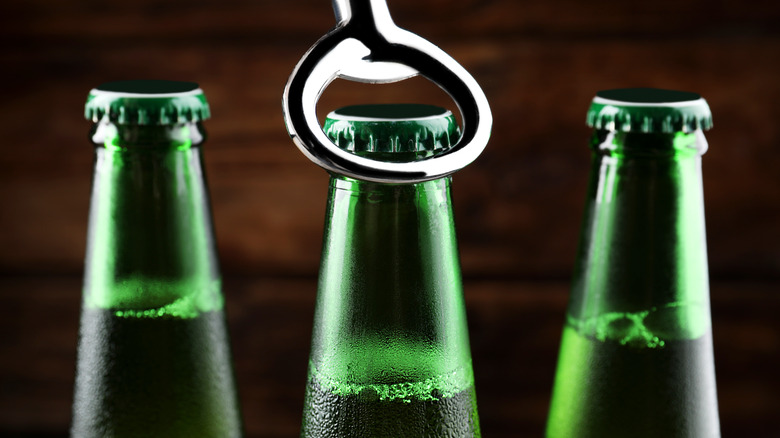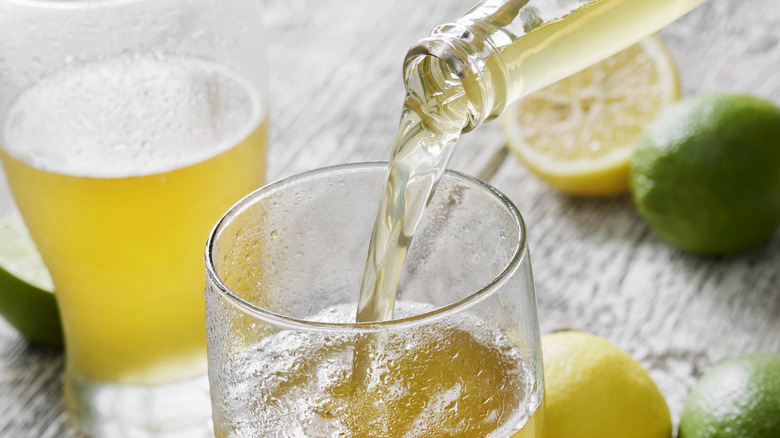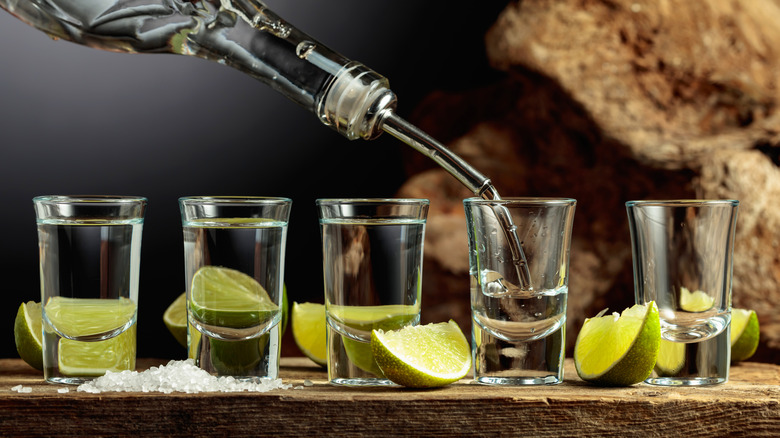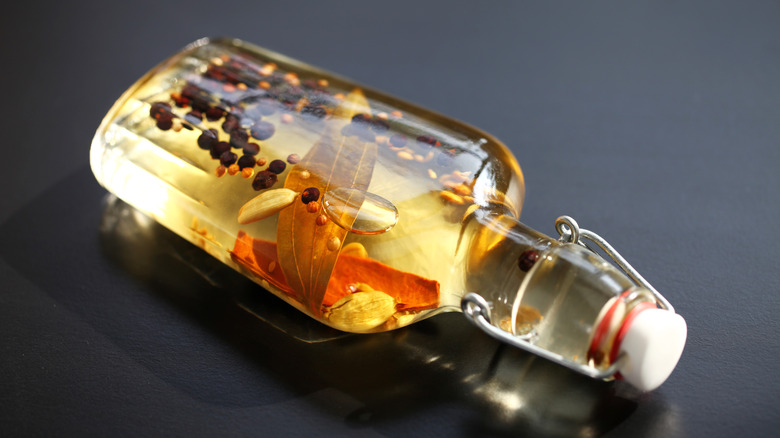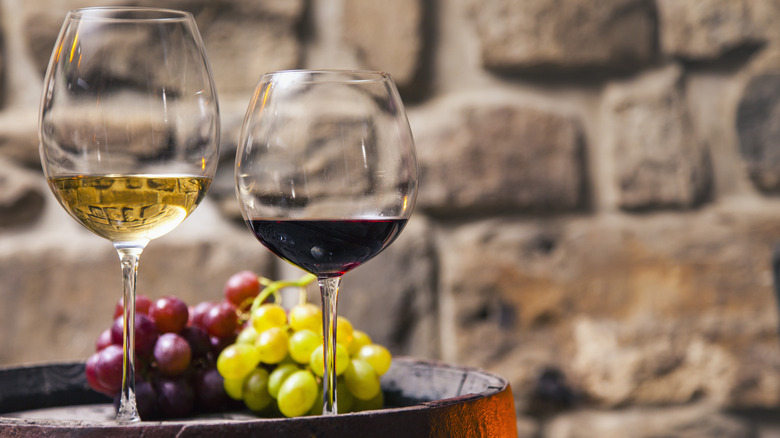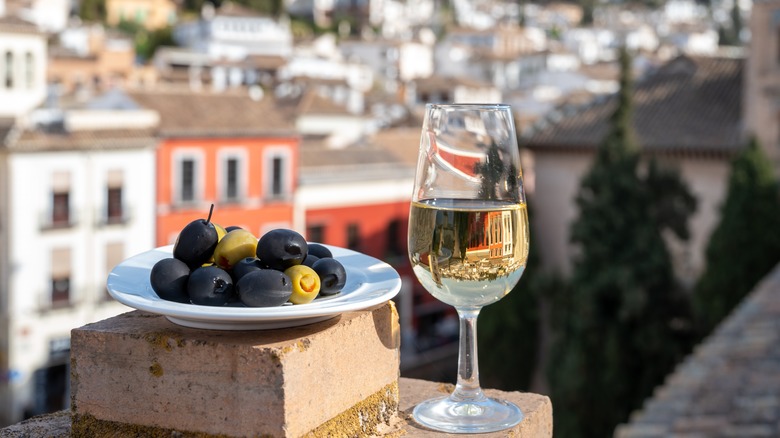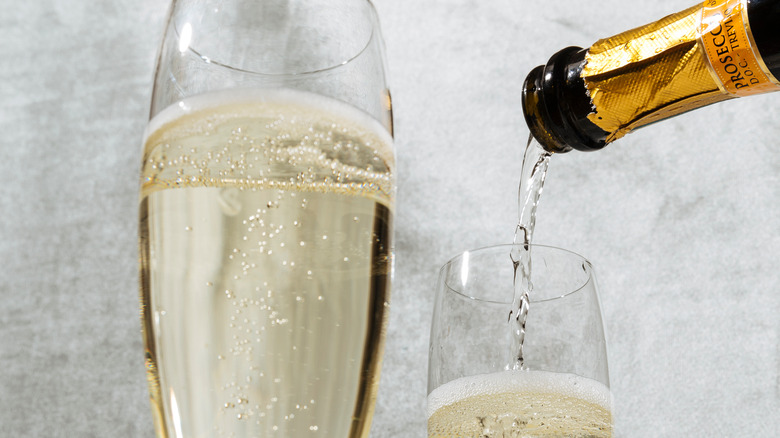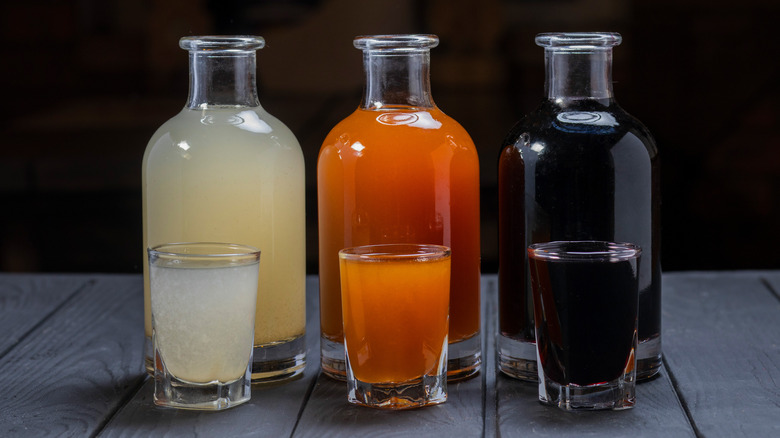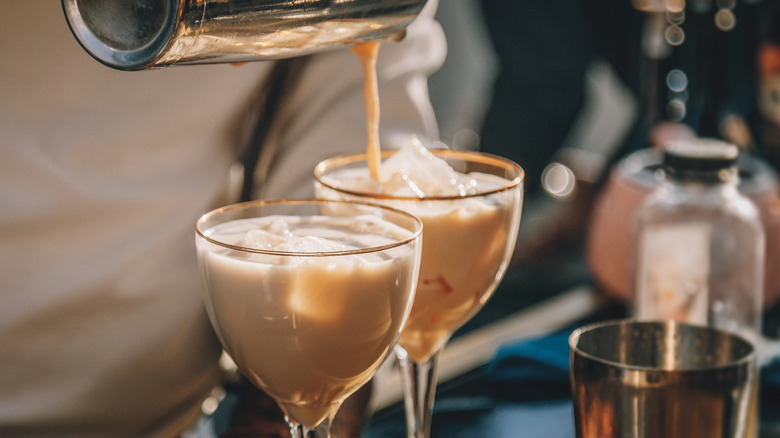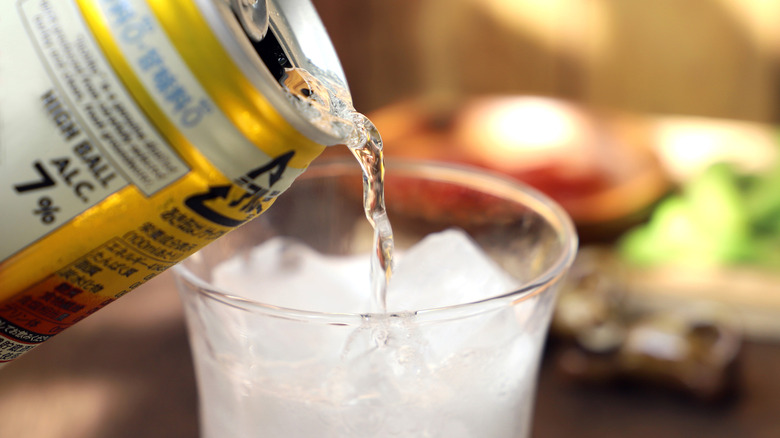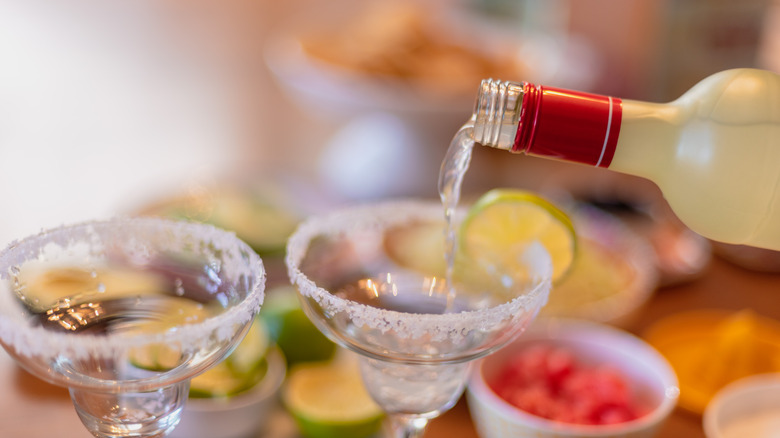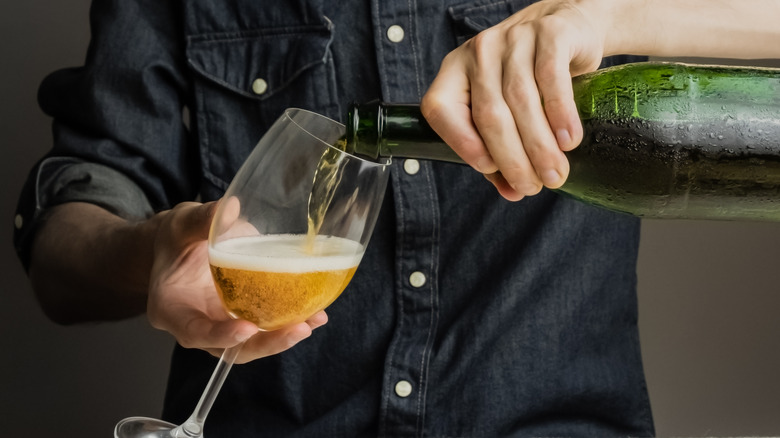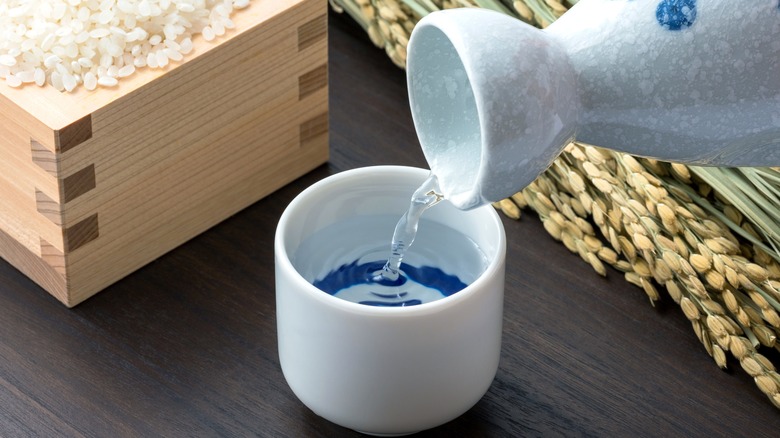How Long Your Favorite Liquors Last After Opening The Bottle
A well-stocked home bar can be a true thing of beauty. There might be beautiful rare bottles of a regional spirit you picked up while traveling or a crate of red or white wine you've stocked up on from a favorite vineyard or winery. Maybe you're a budding mixologist and like to try something new every week. Or, perhaps your home bar is tightly curated with just a few bottles of your hard spirit of choice.
Whatever your bar looks like, big or small, budget-minded or sky's-the-limit, we all face the same concern when it comes to the alcohol we drink: how long will all these different bottles keep for? Some spirits can be stored seemingly forever, and others expire before you know it. And keeping track of all of these varying dates can be a major source of stress and confusion. So, if you've been wondering just how long that opened sake will be good for, or if you need to use up that bottle of Campari you tried once but haven't touched since, keep reading as we break down exactly how long all your favorite types of alcohol and liquor will last once they've been opened.
Beer
As unlikely as it might sound to some of us, it is possible to end up with a leftover, partially filled bottle of beer. Perhaps you were cooking something beer-based, like homemade bread packed with beer, bacon, and cheese. Maybe you were enjoying beer floats or beer margaritas, or even a few rounds of tangy Mexican-inspired Micheladas and opened a few more than you ended up needing.
The important thing to know in all these cases is that if you have a leftover beer that's been opened, it will only keep for 1 to 2 days. To store that excess beer, do whatever you can to reseal the bottle or can. Put some aluminum foil over the top or cover it with plastic wrap held in place with a twist tie or rubber band. Then, put the bottle or can in the coldest part of your refrigerator.
IPAs and ales lose their freshness the most quickly, generally within that 1 to 2-day window; light beers, lagers, stouts, and porters will last a bit longer in the 2 to 4-day range. Have a kegerator at home and fresh beer on tap? Congratulations. Your beer will not only likely taste better than the stuff from a bottle or can, but also last substantially longer as well. Depending on the type of beer you buy, that opened keg will last anywhere from 2 to 4 months.
Spirits and hard liquors
There are so many reasons to love hard spirits like rum, tequila, whiskey, and vodka. One of our favorites? This stuff really does last almost forever, even after it's been opened. Who could ever be mad about that? The reason for these drinks' almost indefinite shelf-life is simple: they're almost all alcohol.
Booze with a high proof is a natural preservative. It has potent antimicrobial properties that can inhibit the growth of bacteria, yeast, and mold. This dramatically reduces the risk of spoilage and ensures the integrity of the spirit over very long periods of time. In fact, there are stories of small caches of alcohol that are super old still being found and sipped today, including a 200-year-old bottle of vodka that was found on a shipwreck off the coast of Poland and that was still perfectly drinkable.
Hopefully, you won't need to store your precious spirits for that long. But if you do want to maximize their shelf-life once opened, try to keep them stored in a cool, dark place away from direct sunlight and heat sources. Keep the bottles upright and tightly sealed to prevent evaporation and oxidation. Also, protect your bottles from temperature fluctuations as much as possible — a cool 60 to 65 degrees Fahrenheit is ideal. Finally, as you pour from each bottle, try to minimize the amount of air that enters each. Pour slowly and smoothly, and then promptly reseal the bottle when done.
Infused and flavored liquors
Infused spirits have been a booming trend in recent years. You might have picked up a premade infusion from a local store or farmer's market. Or, maybe you've tried making your own infused liquor — you can use everything from herbs and spices to chile peppers, citrus peels, fresh fruit, and so much more. Just fill an empty bottle with whatever you want your alcohol to taste like (such as citrus zest, berries, vanilla beans, cinnamon sticks, ginger, lavender, or jalapeño peppers) and then pour in your alcoholic base of vodka, gin, rum, tequila, whiskey, or brandy to top the bottle off. Seal everything, stash it away in a cool, dark place — like the back of your fridge — for a few days, weeks, or even months, and then pop it open and sample your creation.
Depending on exactly what you included in your infusion, your opened spirit should last anywhere from 3 to 6 months. The more perishable the item in your mixture, the shorter the spirit's shelf life. In other words, berry and fruit-infused spirits should be used more quickly than something made with heartier cinnamon sticks or citrus peel.
Prefer to let the manufacturer do the dirty work and add that flavor for you? In that case, it's worth noting that flavored spirits should ideally be used within about 3 months of being opened. The spirit itself won't go bad, but the flavor that's been added may start to change or lose its potency.
Red and white wine
The world's oldest bottle of wine is a 1,700-year-old vessel discovered a few decades back in a historic neighborhood in Rome. Known as the "Speyer wine bottle," many academics believe it could still be drinkable. In comparison, the wine you've got stashed away likely won't last a fraction of that time. But when you do open it, how long have you got? According to most experts, the answer to that question is about 3 to 5 days, depending on factors such as the type of wine, how you're storing it, and how much air has been allowed to enter the bottle.
Typically, when stored in similar conditions, white wine will start to turn a bit faster than red, 3 days vs. red's 5. Crisp, dry wines also tend to last longer than richer, sweeter wines due to their higher acidity levels.
To prolong the life of any opened wine bottle as much as possible, first, be sure to seal the bottle as soon as you are done pouring, and re-cork it tightly to minimize air exposure. You should also store opened wine bottles in the fridge to further slow oxidation and preserve freshness. If you notice any changes in color, odor, or flavor the next time you open the wine, that's a key sign of oxidation and spoilage.
Fortified wines
Fortified wines, like port, Madeira, sherry, marsala, and vermouth, are a favorite in countries like Portugal, Spain, and Italy. For those who've never tried them, these drinks are essentially wines that have been paired with some sort of hard spirit like brandy during the winemaking process. They may look like regular wine, but that "fortification" gives them a much richer and more intense flavor and aroma. Fortified wines often have fruity or nutty notes and hints of caramel flavor. They pair beautifully with cheeses and desserts and are an ideal treat to round out any meal or snack.
Because of their added alcohol and sugar content, fortified wines also last significantly longer than regular wines after they have been opened. In most cases, a fortified wine will still taste great for one to two weeks after you pop open the bottle. Some types will remain good for up to a month, but their flavor can begin to break down and change over time, so you should still drink them as quickly as possible to preserve their optimal flavor.
To maximize the shelf-life of your opened bottle of fortified wine, keep it in a cool, dark place. You can also try to minimize the wine's contact with air — and thereby preserve its flavor and freshness — by pouring it into a smaller bottle (which will allow for less air exposure, and oxidation).
Champagne and sparkling wine
A beautiful bottle of expensive champagne and that discount can of cola you pick up to drink with your lunch actually have a lot in common. They're both carbonated. And that frothy, foamy effervescence is a big part of what makes each so enjoyable.
Soda gets its bubbles through the addition of carbon dioxide gas, which is under pressure. The carbonation in champagne and sparkling wine is created through fermentation and the addition of yeast and sugar to a base wine. The yeast consumes the sugar and produces carbon dioxide, which is then trapped in the sealed bottle, creating all those fantastic bubbles. Pop open your soda or bottle of champagne, and the carbonation is freed — it's an incredible thing. But also very short-lived. An opened bottle of champagne or sparkling wine needs to be used within just 2 to 4 days if you want to enjoy it at its peak.
To maximize the lifespan of an open bottle of sparkling wine or champagne, always re-seal it well, store it in a cool place, and move the bottle as little as possible, as excess agitation releases effervescence inside. Perhaps most importantly, keep the bottle upright, not on its side. As we mentioned with fortified wines, this reduces the wine's surface area and helps to limit its contact with the air, which is what ultimately causes all alcoholic drinks to break down.
Liqueurs, cordials, aperitifs, and digestifs
One of the most rewarding aspects of being a budding mixologist is the sheer volume of drinks to sample, explore, and learn more about. Take the incredible range of drinks known collectively as liqueurs, cordials, aperitifs, and digestifs. Liqueurs like Grand Marnier, Amaretto, and Cointreau are a bit like an infused spirit and tend to be flavored with some sort of fruit, herb, spice, or botanical. But they also have a lower volume of alcohol, which gives them a richer, sweeter flavor profile overall. Cordials are another name for the same type of drink, and the two terms can be used interchangeably.
Aperitifs like Aperol and Lillet Blanc and digestifs like Brandy, Cognac, and Amaro are similar to liqueurs and cordials, but typically focused around meals, either to stimulate appetite or aid in digestion at the end of dining. (as their names suggest).
The one thing all these drinks have in common is that they don't last nearly as long after being opened as a hard spirit or liquor will. Liqueurs and cordials will typically last several months to a year after opening. Seal them tightly and keep the bottles cool and dry. Aperitifs spoil a bit faster and must be used within about 3 to 6 months at most — keep them in the fridge for maximum freshness. And with digestifs, you get a bit longer, 1 to 3 years in most cases. No need to chill — just keep them cool, dark, and dry!
Cream liqueurs
Baileys. Kahlúa. RumChata. Godiva chocolate liqueur. Tia Maria. Liquor stores are packed with all sorts of creamy, decadent alcohols — a class of drinks typically known as cream liqueurs. And there's a good reason for their popularity. These drinks are like the candy or ice cream of the alcohol world. They're sweet, luscious, and fabulous in so many different ways — neat or on the rocks, mixed with coffee, poured into a dessert, or used as a topping on cakes, brownies, or pies. And, of course, they're ideal for any number of incredible cocktails, from Mudslides and White Russians to so much more. You can even make homemade Kahlua — it's easier than you might think!
As for the shelf life of these wonderful treats, once they've been opened? Most experts agree they should be used within about 6 months, although some can maintain their freshness and flavor for a year or more. One good rule of thumb to consider is each individual bottle's ABV, or alcohol by volume. The higher that number is — the more alcoholic the drink — the longer it should last because of alcohol's preservative properties.
Although cream liqueurs don't have to be stored in the fridge, it helps, and will increase how long they last once opened. If refrigeration isn't an option, at least keep them tightly sealed, stored upright, and ideally in a cool, dark place.
Canned ready-to-drink cocktails and hard seltzers
As surprising as it might seem, we live in a golden era for "ready-to-drink, canned cocktails." Beer has dropped in popularity, and beverage industry statistics show that pre-made canned cocktails and hard seltzers are becoming the drink of choice for countless individuals — we're talking double and triple-digit growth in an industry that shows no signs of slowing down any time soon. And for you doubters out there, let's clear up this question once and for all: Yes, hard seltzer really is more than just "a vodka soda in a can."
The reason for this explosive popularity is obvious. RTD drinks (as they're known in the biz) are convenient, relatively healthy (as far as alcohol goes), and taste great. The one drawback? Unlike the hard spirits they're based on, canned cocktails and hard seltzers don't last forever. Most cans are good for about six months to a year. Search around on the packaging — each can should have an expiration date printed on its label.
Once opened, these cans last an even shorter period — around a day or two at most. They're meant to be opened and consumed in a single sitting, or as close to that as you can get. So, if you open a can and don't like it, don't stash it in the fridge and plan on returning to it later. Give it to a friend or mix it with something else and use it up right away ... it won't keep.
Bottled drink mixes with alcohol already mixed in
With canned cocktails popping up in more and more places, it makes sense that "ready-to-drink" bottled cocktails — essentially a mixer plus alcohol — are also more popular than ever. There are definite winners and losers for sale. Some margaritas and pre-made rum punches, for example, can be wonderfully tart and refreshing and taste like they could have come straight from your favorite bar. Others are super syrupy and artificial tasting — no better than the terrible mixers they were initially based on.
Whichever type you ultimately end up with — good or bad — know that it should be used up within about 4 to 6 months after you open it. Bottles should be kept continuously refrigerated. Don't leave them out on your bar like a regular bottle of tequila. (Sour mix itself should also always be stored in the fridge.) And as tempting as it might be to shake the bottle before you pour some of the pre-made drink out, don't. This just introduces extra air to the liquid and speeds up its potential breakdown. You can shake an individual serving of the premade drink in a shaker with ice — just don't shake the whole bottle.
Hard ciders and hard kombuchas
We might be in the era of canned cocktails, but hard ciders and hard kombuchas are not far behind in terms of growing brand dominance. Both drink classes are more popular than ever, and continuing to grow and expand in all sorts of ways.
As the name suggests, hard cider is essentially just a type of alcoholic apple juice that's enjoyed straight from the bottle, paired with a meal, or sometimes used as a cocktail ingredient. As for kombucha, this uber-trendy drink is ultimately a fermented, lightly effervescent form of sweetened black tea. To make the drink "hard" or alcoholic, its fermentation is allowed to go on for a much more extended period, increasing the kombucha's alcohol content substantially.
Hard ciders and hard kombuchas differ from beers and canned cocktails in that they are typically served in much larger, multi-serving bottles — so it's natural to have leftovers after the bottle is opened. For optimal flavor and quality — and to enjoy maximum fizziness in your drink — both should be consumed within about 1 to 2 weeks of when you first pop their top. As with most of the other drinks we've profiled, the best way to prolong the lifespan of each drink is to refrigerate each promptly, ensure their lids are tightly sealed, and minimize their exposure to light. Bottoms up!
Sake and soju
Last, but certainly not least, we come to sake and soju — two jewels of the Asian beverage scene. Japanese sake (or rice wine) is an ancient drink with a history dating back more than 2,500 years. Soju (a rice-based spirit and Korean favorite) has an equally impressive lineage, dating back to the 14th century. Infamous ruler Genghis Khan and his grandson Kublai Khan were both fans of the drink and contributed to its spread and popularity throughout Asia back in the day.
Fast-forward to today, and sake and soju remain some of the most popular drinks around, enjoyed both on their own or mixed into a wide variety of cocktails, like this incredible watermelon and soju pairing. Safe and soju bottles can vary widely in size, and it's common to have a bottle you don't use completely in a single sitting. Fortunately, sake oxidizes more slowly than grape-based wines, so you have about a week to use it up after your first drink. (If sake has been warmed, that time can dip dramatically, so only heat enough sake as you plan on drinking with a meal.)
As for soju, think of it more like a spirit than a wine because of its higher alcohol content. Once opened, it can last several years without any noticeable changes in flavor or consistency. So enjoy — raise your glass in the air, clink it with those of your table-mates (just as they do in Korea ), and say a hearty, "Cheers" or "geonbae."

